Originally posted by marnop
View Post
Het bewijs: plank beter voor core dan crunch
Collapse
X
-
Hier heb ik helemaal geen grafiek voor nodig, je "voelt" toch ook gewoon dat plankholds meer doen met je core?
Abwheel rollouts zijn meesterlijk idd Revius..In adaptation we trust
Deadlift 285 kilo
Squat 230 kilo
Bankdrukken 137.5 kilo
Powerlift totaal 652.5 kilo
Mijn trainingslog
Comment
-
@ Robbie
Mijn punt is dat je niet kunt kwantificeren of de oefening goed is, aan de hand van een paar atleten met een genetische aanleg die ze nog wel een topfysiek zou geven met een men's health kantoorschemaatje. Dat is waarom je niet kunt aandragen dat zij bewijzen dat crunches beter zijn dan plank holds. Het enige wat je nu (zou kunnen) aantoont (aantonen) is dat crunches wel wat doen t.o.v. ze niet doen. Net zoals je niet kunt zeggen dat leg presses werken voor spiergroei, en ze dus beter zijn dan squats. Je vergelijkt namelijk niks."Een zoektocht naar kennis moet los staan van het moreel van goed of kwaad, anders is die toch gedoemd niet volledig te zijn." - Genjuro
sigpic
"Rock is overpowered. Paper is fine" -Scissors-
Comment
-
Het is sowieso vrij lastig om aan te tonen of buikspieroefening veel doet qua spiergroei in een compleet schema waar je core al zwaar wordt belast met squats, deadlifts, overhead werk, bent over rows etc.
Je zou dan al die oefeningen weg moeten laten en dan een tijdje alleen planks doen voor je buik en later alleen crunches. Maarja wie gaat zoiets doen?
En daarbij zou om de progressie te zien, de atleten waarop het onderzocht wordt ook nog eens precies op hetzelfde vetpercentage moeten blijven staan.Groeten
Comment
-
Voor de liefhebbers van leesvoer en leuke conclusies.....check deze eerste afbeelding en lees de gehele tekst.:
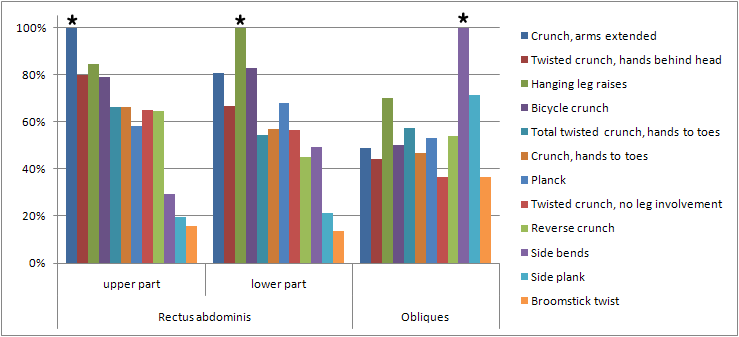
SuppVersity EMG Series - Rectus Abdominis, Obliques and Erector Spinae: The Very Best Exercises For Sixpack Abs and a Powerful Midsection
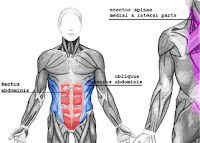 Image 1: There is more to a strong core
Image 1: There is more to a strong core
than just the m. rectus abdominis aka
'the abs' (red); its imperative to train your
obliques (blue) and the muscle strands
of the erector spinae muscles which
stabilize your spine (violette)"6 weeks to 6-pack abs" - although we all know that this is unattainable for the majoritity of beer-bellied casual Men's Health reader, headlines like that still make the sales of today's fitness magazines go up. On the other hand, Charles Atlas, John Grimek, Ray Parks, Eugen Sandow and the other fathers of physical culture would certainly turn in their graves, if they saw the metrosexual size zero bans on the covers of respective 'lifestyle' magazines and read about the 'cult of sculpted abs' that has befallen their 'grandchildren'... well, I guess you don't care about those 'grandpas', let alone my rants, and still want your sixpack to shine in its full glory on the next spring break, no matter what? Ok, but beware, even the best exercises won't help, as long as your glorious rectus abdominis is covered by an unaesthetic layer of adipose tissue - the key to sculpted abs is dieting! As far as core training is concerned, it is imperative to understand that building a stable core, which is a major yet often disregarded prerequisite for lifelong mobility, is not only about 'ab-training'. Its about training all those exterior and interior muscle strands that keep you upright:- the m. rectus abdominis (image 1, red), which consists of two parallel muscle strands that run vertically on each side of the anterior wall of the human abdomenis and are often simply referred to as 'the abs'
- the external and internal oblique muscles (image 1, blue), which pull the chest downwards and compress the abdominal cavity (external) also have a limited action in both flexion and rotation of the vertebral column (both) and cover the transverse abdominis muscles, which are located beneath the obliques and help to compress the ribs and viscera, thus providing thoracic and pelvic stability
- the muscles of the erector spinae (image 1, violette), which are of paramount importance to your life, because they stabilize and protect your spine

 ChestBicepsBackCoreLegsTricepsShouldersNavigate the SuppVersity EMG Series - Click on the desired body part to see the optimal exercises.The SuppVersity proudly presents: The most effective exercises, as measured by electromyography (10 male resistance-trained subjects, mean age 22y, mean body-fat 13%; data from Boeckh-Behrens & Buskies. 2000) for your abs, your obliques and your the stabilizer muscles...
ChestBicepsBackCoreLegsTricepsShouldersNavigate the SuppVersity EMG Series - Click on the desired body part to see the optimal exercises.The SuppVersity proudly presents: The most effective exercises, as measured by electromyography (10 male resistance-trained subjects, mean age 22y, mean body-fat 13%; data from Boeckh-Behrens & Buskies. 2000) for your abs, your obliques and your the stabilizer muscles...
I. Training the m. rectus abdominis (aka 'the abs') & the oblique muscles
I want to begin with a word of caution, although 'the abs' do in fact comprise two muscle strands, the two strands ran vertically and parallel to your spine. The assertion that there are 'upper' and 'lower' abs is thus not supportable from a purely anatomical point of view. If you do ab-exercises and even more so, if you do full body movements like squats, deadlifts or military presses, the muscle strands of your rectus abdominis (as well as your obliques and the erector spinae muscles) will always be engaged as a whole. As it is the case for the latissimus dorsi, another of the large muscle groups in your body, it is yet possible to put a special emphasize on the upper or lower part of your abs. Remember that, when you read about the best exercises for 'upper' and 'lower part' of the m. rectus abdominis in the following overview.
Six or eight packs - genetics or training? It is an urban or, I should say a 'gym myth' that you "progress from a six- to an eightpack" by training your abs until they hurt. The way your 'abs' look, which includes the number of packs, is determined by genetics and body fat level. The latter, by the way, is the reason why so many trainees believe they would just have to keep training until - almost magically - the 7th and 8th pack would pop up. While this does work for many people, it is not because of training-induced hypertrophy, but rather due to atrophy - adipocyte-atrophy, or fat loss to be precise. Especially the lowest of the six or eight packs tend to be covered by a very stubborn layer of stress-fat, that's why many peple begin to see them, when their training advances and their body fat levels drop.
The EMG data from Boeckh-Behrens & Buskies also goes to show that even in the case of the rectus abdominis and the external and internal oblique muscles, true isolation is impossible. Everytime you engage in any type of core exercise both the central, as well as the lateral stabilizers or, in other words, the abs and the obliques will be working.
 Figure 2: EMG activity of m. rectus abdominis (upper part), m. rectus abdmonis (lower part) and oblique muscles during twelve selected core exercises relative to muscle(-part) specific reference exercises as indicated by the asterisk '*' (data adapted from Boeckh-Behrens & Buskies. 2000)The graphical illustration of the relative EMG activity of twelve selected core exercises confirms the statement that any given exercise for the 'abs' will inevitably also involve a certain degree of oblique activity. It is however also quite obvious that trainees can easily emphasize a certain muscle group (or part) by selecting the appropriate exercises from the following top 12:
Figure 2: EMG activity of m. rectus abdominis (upper part), m. rectus abdmonis (lower part) and oblique muscles during twelve selected core exercises relative to muscle(-part) specific reference exercises as indicated by the asterisk '*' (data adapted from Boeckh-Behrens & Buskies. 2000)The graphical illustration of the relative EMG activity of twelve selected core exercises confirms the statement that any given exercise for the 'abs' will inevitably also involve a certain degree of oblique activity. It is however also quite obvious that trainees can easily emphasize a certain muscle group (or part) by selecting the appropriate exercises from the following top 12:
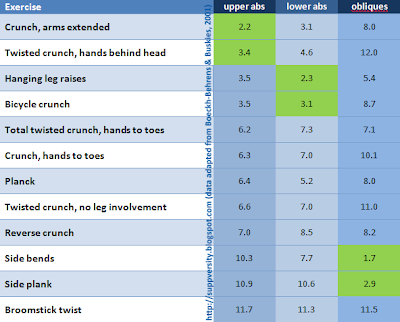 Table 1: Top 12 ab- and oblique exercises; ranking according to Boeckh-Behrens & Buskies, 2000It is quite obvious that with a set of 3-6 exercises (I marked the top exercises in green) you can effectively train the whole anterior part of your core and still keep enough variety to avoid getting bored - and, what's probably even more important, to "keep your body guessing". It is yet also obvious that much more than it is the case with exercises for other body parts, there is huge inter-personal variety in terms of which ab-exercises work best for whom. Therefore I decided to give you some additional data on the exact mean ranks of the specific exercises - something I omitted in the previous issues of the SuppVersity EMG Series simply because (with the exception of the chest, where I mentioned it in the text) the mean rank and the mean EMG activity toplists would have been identical, anyway.
Table 1: Top 12 ab- and oblique exercises; ranking according to Boeckh-Behrens & Buskies, 2000It is quite obvious that with a set of 3-6 exercises (I marked the top exercises in green) you can effectively train the whole anterior part of your core and still keep enough variety to avoid getting bored - and, what's probably even more important, to "keep your body guessing". It is yet also obvious that much more than it is the case with exercises for other body parts, there is huge inter-personal variety in terms of which ab-exercises work best for whom. Therefore I decided to give you some additional data on the exact mean ranks of the specific exercises - something I omitted in the previous issues of the SuppVersity EMG Series simply because (with the exception of the chest, where I mentioned it in the text) the mean rank and the mean EMG activity toplists would have been identical, anyway.
Perfect form counts, especially on the advanced movements
Image 2: Trainees tend to (ab-)use the psoas major and thus decrease the activation of the 'abs', when doing leg raises, sit-ups etc. (image by Beth ohara @ Wikipedia)
A perfect example of improper form compromising exercise efficiacy is the hanging leg raise, where, in the case of the upper part of the m. rectus abdominis, you can see that the exercise must have produced an extraordinarily high EMG activity in some, and a rather mediocre muscular activation in other subjects. Otherwise the ranking according to mean EMG for the exercise over all subjects (rank 2) and the mean exercise rank for the individual (rank 3) would be identical. Those of you who know how to do the exercise properly will know that even under professional supervision many trainees fail to actually flex their abs and thus train their psoas major (cf. image 2) instead of their abs, when they hang like a flabby sack from the bar and swing their legs up and down. A similar shift away from the m. rectus abdominis and towards the psoas, occurs in all ab-exercises where your legs are held in a fixed position, the most dreaded example being the classic sit-up, from which generations of trainees developed a hollow back (hyperlordosis); a pathology that cannot only entail lower back pain, but will also make your abdomen stick out even further, the result of which would be an untrained pair of abs that "sticks out" not in the intended metaphorical, but in the unwanted literal sense. Don't get me wrong, I am not generally against doing sit-ups, let alone leg raises (they are in fact among my favorite core exercises), I just want you to make sure, you are doing them right, so that you...- do not get hurt,
- do not develop muscular imbalances, where despite or rather due to improper ab training your m. rectus abdominis becomes the weakest link and thus
- do not put yourself at danger of developing a (painful) hollow back and an untrained pair of abs on a portruding abdomen
Exercise tip #1 - the road to correct hanging leg raise: Done properly, hanging leg raises are the king of all ab-exercises, which does yet require practice and a core that is already pretty strong. Therefore I would suggest beginners start out with the lying leg raises with their hands or one of those pillows under their lower back for lumbar support. By trying to press their hands / the pillow into the floor in the course of the movement, they will develop the core stability that is necessary to progress- from the supported to the unsupported lying leg raises
- from leg raises on the floor to leg raises on a decline
- from decline leg raises to hanging leg raises
I suppose, some of you may be disappointed, that exercises like the cable crunch or your favorite abdominal trainer have not made it to the list. While I think that many of the ab-machines share the same problematic psoas major activity as improperly executed hanging less raises or sit-ups, I count the cable crunch among the most effective ab exercises one can do.
Image 3: Exercise variation is key, especially for advanced trainees, who do not want to hit a plateau. Therefore, even self-proclaimed 'pros' should not back off from stability exercises like the side plank, which is the 2nd most effective exercise for the oblique muscles in the top 12 (image from www.everkinetic.com)That being said, EMG data, no matter how scientifically objective it may seem, should never have you give up what works for you. Ab training, just like everything else you do in the gym, is not about doing, but about feeling the movement. Or, in other words, if the consequence of extending your arms behind your head is that you stop feeling how your upper abs are contracting, chances are that the purported #1 exercise for the upper part of the m. rectus abdominis, the crunch with extended arms, is not for you. The possible reasons for that are manifold, with the two most likely reasons being that you're simply not doing the exercise right (remember: doing crunches is not about raising your head off the floor ;-) and/or the exercise intensity is not appropriate for your training level. The latter is an oftentimes overlooked factor which hampers progress in beginners and advanced trainees, alike. I've hinted at this in exercise tip #1, already rookies need to build a foundation before they start doing 'advanced' exercises such as hanging leg raises - you would not tell a toddler who has just taken his/her first steps to go and compete in the Olympic 200m race, would you? In the same vein, you will probably get neck and lower back problems if you start doing 100s or 1000s of 'ballistic' sitpus, where you're virtually trying to lift your upper body from the floor by pulling it up from your ears or the back of your head. Believe me, many of the pot-bellied weekend warriors I see doing this type of "ab training" would be better off doing a single set of 6-12 properly performed crunches with peak contractions. Unfortunately, many of them cannot do even one of those, because their m rectus abdominis is simply too weak to lift their massive upper body off the floor. Similarly, I see some advanced trainees still perform an hour-long crunch workout, carefully making sure that they perform at least 50 reps of each and every funky move they have ever seen in one of those stupid fitness magazines - come on guys (interestingly only few girls seem to be stupid enough to do so), I know you have not been making progress in years... always remember. progress, or rather progressive muscular (not lumbar ;-) overload that is the key to success in whatever you do in the gym.
Exercise tip #2 - Exercise intensity and the myth of high-rep-training for abs: In that it is important to accept that they may be no limit to the number of 1.25 pounds of weight you want to try to add to the bar every week, there certainly is one to adding another rep to the number of crunches, leg raises or side-bends you perform. In the case of the crunch, for example, the beginner would first have to practice doing the basic crunch right, to feel his abs working, to be able to stop half-way up or down and deliberately contract his muscles and to "peak-contract" his m. rectus abdominis until it hurts. The advanced trainee, on the other hand, will have to refrain from increasing the number of reps beyond a max of 20 reps. Instead, they should focus on increasing torque by either- varying the position of his arms - beginner: hands support lower back; intermediate: hands on the chest / at the sides of your head; advanced: arms extended behind the head
- adding light weights - e.g. holding a light dumbbell in your hands when you do the crunch with your arms extended behind your head, on the leg raises you could use some of those weight straps for the ankles, etc.
- switching to more advanced exercises - properly executed hanging leg raises, for example, activate the upper part of the abs almost as effectively as crunches; they are the #1 exercise for the lower abs and #3 for the obliques; but they are difficult to do and require an already fortified core (cf. exercise tip #1)
If you are doing the right exercises and increase reps and then weights, incorporate advanced exercises and still do not see progress, I can tell, without even even knowing what you had for breakfast that it ruined your efforts in the gym. Having great abs is 75% diet and 20% whole body training and 5% ab training, remember that whenever you get the idea that doing another 100 sit ups or training your abs every day (every other day = max) would magically melt the fat away... you better save the time for some serious squatting, deadlifting or high intensity interval training if you want your abs to shine in their full glory. II. Training the erector spinae (focus on lumbar part) Contrary to having "great abs", which is probably the #1 on the wish-list of trainees in gyms all around the world, impressive erector spinae muscles appear to be way less popular in a world where the divide between morbidly obese exercise dyslectics and ripped exercise freaks is ever increasing. And while the former simply ignore that a strong lower back may save them from a whole host of minor ailments of will experience on top of heart disease, diabetes and Alzheimer's in their later life, the latter keep looking at their sixpacks and simply take for granted that the literal flipside of what they consider the epitome of a fit and healthy body (their sixpack) would look alike. Sometimes this may be the case, more often than not, those are however the same guys and girls who neither squat or deadlift, because they falsely assume that this would make them bulky. The EMG data by Boeckh-Behrens & Buskies goes to show that, due to this commonly held misconception many trainees miss out on the two most effective (hard-)core exercises.
 Image 4: Variations of the deadlift (here the romanian deadlift) are still the most basic lower back movementsThe best exercises with standard equipment
Image 4: Variations of the deadlift (here the romanian deadlift) are still the most basic lower back movementsThe best exercises with standard equipment- Leg raises on the lying leg curl machine*
- Classic squat
- Hackquat machine
- Deadlift (100% body weight)
- Romanian deadlift (50% body weight)
- Partial Deadlift (50% body weight)
Figure 3: EMG activity of erector spinae (lumbar part) during six selected core exercises with standard equipment relative to the "king of all exercises", the squat (data adapted from Boeckh-Behrens & Buskies. 2000)I consider it noteworthy that the decrease in weight on the deadlift (done to avoid injury) obviously takes away from the EMG activity Boeckh-Behrens & Buskies were able to measure. It is thus highly likely, that
- the deadlift is the most taxing and at the same time most stimulating exercise for the muscles of the erector spinae, and
- the partial romanian deadlift (legs straight) is probably even more taxing and thus more stimulating than the "classic" deadlift (the EMG data seems to confirm that, as the subjects lifted 2-times the amount of weight on the classic deadlift, yet the muscular activation increased by only 76%)
 Image 5: The flutter kick with endcontractions & the pelvic lift, which is similar to the lying hip extension with the exception that you bend the free leg (100°) turn to be slightly more effective than the good old reverse extensionsThe best body-weight exercises
Image 5: The flutter kick with endcontractions & the pelvic lift, which is similar to the lying hip extension with the exception that you bend the free leg (100°) turn to be slightly more effective than the good old reverse extensionsThe best body-weight exercises- Flutter kicks, prone position, with peak contractions
- Pelvic lift, knee angle 100°
- Hyper-/reverse extensions
- Bird (plank position, no arm activity)
- Sitting upright arms spread like an eagle
Figure 4: EMG activity of erector spinae (lumbar part) during five selected body-weight exercises relative to the well-known hyper-/reverse extensions (data adapted from Boeckh-Behrens & Buskies. 2000
III. Conclusion: 3 basic moves for a fortified core!
I suppose, there were not too many big surprises in this issue of the SuppVersity EMG Series, or at least I would hope so... you did not believe all those exotic contortions Men's Idiocy & co invent each spring to attract new readers would be worth doing. Did you? Some sort of crunch, some leg raises and one of the core (this refers to both your core as well as the core of your workout) exercises, i.e. deadlifting or squatting max 2-3 times a week is all it takes to fortify the center of your body. If you want the additional bonus of a shiny six (or eight-)pack, do at least as many squats and deadlifts as you do crunches, add in some HIIT (high intensity interval training) and stick to your diet.
 Image 6: You asked for it, here is the
Image 6: You asked for it, here is the
info - the ab-roll-out probably is probably
among the most effective ab-exercises, as well.User requested update: "Dr. Andro What about the Ab-Roll-out?" This question has now been posed twice and not only because one of the persons who asked was my Buddy Duong, I dug a little in the archives of exercise sciences and came up with a study that compared 8 Swiss ball exercises (roll-out, pike, knee-up, skier, hip extension right, hip extension left, decline push-up, and sitting march right) and 2 traditional abdominal exercises (crunch and bent-knee sit-up) and found that EMG signals for the upper and lower part of the m. rectus abdominis, as well as the obliques were "greater compared to most other exercises". In that it has to be said that the movements were performed for 5 reps only and that even the authors remark that higher / more diverse repetition ranges could have influenced the overall results they summarize in their conclusion as follows: "The roll-out and pike were the most effective exercises [in this study! a direct comparison of the EMG data with the one from the Boeckh-Behrens Buskies study would of course be invalid] in activating upper and lower rectus abdominis, external and internal obliques, and latissimus dorsi muscles". Bottom-line: Daron, Duong & the rest - keep doing your roll-outs, if you like them ;-)
An EMG-optimized routine
 Image 7: The kneeling cable crunch (image shows seated) is one of my favorite exercises for the m. rectus abdominis; although the authors did not measure EMG activity, Boeckh-Behrens & Buskies explicitly mention this ab-exercise as being particularly effective for advanced trainees (image from everkinetic.com)
Image 7: The kneeling cable crunch (image shows seated) is one of my favorite exercises for the m. rectus abdominis; although the authors did not measure EMG activity, Boeckh-Behrens & Buskies explicitly mention this ab-exercise as being particularly effective for advanced trainees (image from everkinetic.com)
There is of course a myriad of ways of combining the individual exercises, my personal recommendation for overall core development (based on EMG measures) would yet be as follows*:- Crunches < 20 reps; vary arm / hand position or add weight + peak contractions to build intensity without going past max. 25 reps
- Leg raises < 15 reps; vary according to exercise tip #1; do at least one of your sets with your legs / torso rotating sideways, alternate left and right
- Deadlift variety 10-12 controlled reps; select the deadlift variety you feel isolates your lower back best
- Kneeling cable crunch < 15 reps; add weight whenever possible
- Side bends < 15 reps; add weight if necessary, be cautious not to bend over or go into hyperlordosis
- Hyperextensions** < 12 reps, with proper form + peak contraction; add weight if necessary
1e Masters Superbody YBF 2011!
Go M.U.D. Mart's Ultimate Diet ©
Comment
-
de bron van bovenstaande post: SuppVersity - Nutrition and Exercise Science for Everyone: SuppVersity EMG Series - Rectus Abdominis, Obliques and Erector Spinae: The Very Best Exercises For Sixpack Abs and a Powerful Midsection
er staan op die website nog veel meer EMG meet-resultaten.1e Masters Superbody YBF 2011!
Go M.U.D. Mart's Ultimate Diet ©
Comment
-
Interessant artikel. Het is alleen niet echt een onderbouwen voor jouw mening. Als ik het zo lees krijg ik de indruk dat de auteur van mening is dat je de grote compounds geewoon als basis moet gebruiken, met daarbij nog wat buikspierplezierkwartier.
Om maar iets te citeren:
Maargoed, ik ben dan in zijn geheel niet echt een voorstaander van buikspieroefeningen. Buikspieren en andere 'core components' moeten mijns inziens gewoon functioneel zijn: Sterk genoeg om je stabiel te houden bij zelfs de zwaarste setjes squatten en deadliften. Als ze dan groeien: leuk, je hebt een sixpack. (Mits je goed dieet natuurlijk) Als ze niet groeien: leuk, een smalle taille met brede schouders, ook een plezant uitzicht, toch?Having great abs is 75% diet and 20% whole body training and 5% ab training, remember that whenever you get the idea that doing another 100 sit ups or training your abs every day (every other day = max) would magically melt the fat away... you better save the time for some serious squatting, deadlifting or high intensity interval training
Uiteraard vooropgesteld dat je laag in bf zit. Zit je dat niet, dan zal de effectiefste oefening voor een goede buik nog altijd HIIT zijn, en geen crunches of zelfs zware compounds.Één bodybuilder kan meer eieren eten dan tien kippen kunnen leggen.
Comment
-
wat moet er verder onderbouwd worden dan? De EMG onderzoeken en uitkomsten zeggen genoeg PLANK is NIET de beste manier!Originally posted by seanl94 View PostInteressant artikel. Het is alleen niet echt een onderbouwen voor jouw mening. Als ik het zo lees krijg ik de indruk dat de auteur van mening is dat je de grote compounds geewoon als basis moet gebruiken, met daarbij nog wat buikspierplezierkwartier.
1e Masters Superbody YBF 2011!
Go M.U.D. Mart's Ultimate Diet ©
Comment
-
Jazeker hoor marnie, dit is wat er staat in de openingspost:Originally posted by marnop View Postwat moet er verder onderbouwd worden dan? De EMG onderzoeken en uitkomsten zeggen genoeg PLANK is NIET de beste manier!
En daar ga je niets aan veranderen, maakt niet uit hoe hard je op de grond stampt. Tjongejonge, je lijkt wel een koppig kind van 3 jaar oud dat driftig wordt omdat het zijn zin niet krijgt. Ongelooflijk.De onderzoekers plakten elektroden op de spieren van 20 proefpersonen, en lieten de proefpersonen vervolgens 16 core-oefeningen uitvoeren. Via de elektroden konden de onderzoekers zien hoe intensief de oefeningen de spieren van de proefpersonen activeerden. Hoe meer electrische activiteit in een spier, des te harder moet die spier werken.
De figuur hieronder vertelt dat de core-spieren harder moeten werken tijdens een plank [rechtsonder; voorgrond in de grafiek] dan tijdens een crunch [linksonder; achtergrond in de grafiek].
AD = anterior deltoid, RA = rectus abdominus, EO = external abdominal oblique, TE = thoracic erector spinae [de spier die van je schedel tot aan je heupbeen langs je ruggengraat loopt], LE = lumbar erector spinae [de onderrugspier], GM = gluteus maximus.
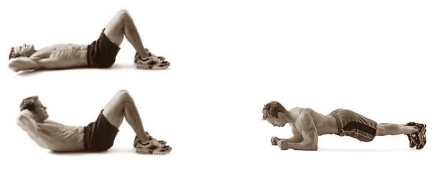
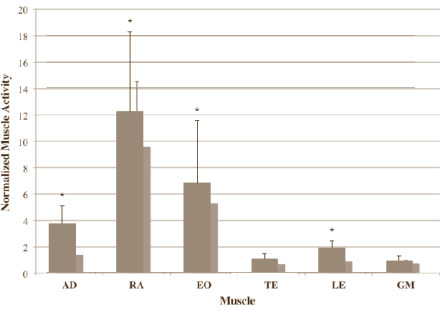
Hieronder zie je een vergelijking tussen de superman [linksonder; achtergrond in de grafiek] en de pointer [rechtsonder; voorgrond in de grafiek].
De superman is net zo'n isolatie-oefening als de crunch. Je ligt op de grond, en trekt je benen en borst omhoog doordat je je gluten en onderrugspier samentrekt. De pointer lijkt meer op de plank. Je brengt je lichaam in een houding waarin je corespieren hard moeten werken om je wervels stabiel te houden. De figuur hieronder maakt duidelijk welke van de twee de betere oefening is.

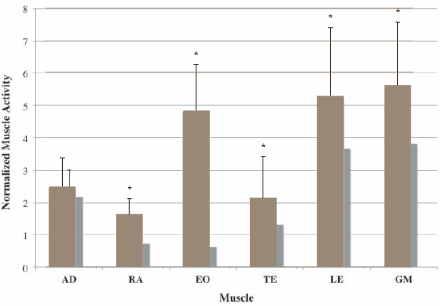
I know from teaching hundreds of seminars that the guys who say they have “awesome technique” are usually the biggest disasters—their ego just doesn’t let them see it.
- Dave Tate
Comment
-
Dit is het abstract van het onderzoek:Originally posted by talalelh15 View PostMaar wat is de definitie van harder moeten werken ten opzichte van wat
?
De resultaten tonen dus aan dat oefeningen waarbij de delts en glutes betrokken zijn meer spieren in je core activeren in vergelijking tot oefeningen waarbij deze niet zijn betrokken.INTEGRATION CORE EXERCISES ELICIT GREATER MUSCLE ACTIVATION THAN ISOLATION EXERCISES.
Gottschall JS, Mills J, Hastings B.
Source
1The Pennsylvania State University, University Park, USA 2Les Mills International, Auckland City, NZ.
Abstract
ABSTRACT:: The American College of Sports Medicine and the United States Department of Health and Human Services advocate core training as a means to improve stability, reduce injury, and maintain mobility. There are countless exercises that target the primary core trunk muscles (abdominal and lumbar) with the aim of providing these benefits. However, it is unknown which exercises elicit the greatest activation thereby maximizing functional gains as well as peak performance. Thus our purpose was to determine whether integration core exercises that require activation of the distal trunk muscles (deltoid and gluteal) elicit greater activation of primary trunk muscles in comparison to isolation core exercises that only require activation of the proximal trunk muscles. Twenty participants, 10 men and 10 women, completed 16 randomly assigned exercises (for example, crunch, upper body extension, and hover variations). We measured muscle activity with surface electromyography of the anterior deltoid, rectus abdominus, external abdominal oblique, lumbar erector spinae, thoracic erector spinae, and gluteus maximus. Our results indicate that activation of the abdominal and lumbar muscles was greatest during the exercises that required deltoid and gluteal recruitment. In conclusion, when completing the core strength guidelines, an integrated routine that incorporates the activation of distal trunk musculature would be optimal in terms of maximizing strength, improving endurance, enhancing stability, reducing injury, and maintaining mobility.
bron: Home - PubMed - NCBI
Tot de core oefeningen waarbij de delts en glutes zijn betrokken behoren onder andere "mount climbers", "plank holds", "side planks" en "birdogs". En het mooie van planks is dat je deze ook met gewichten kunt doen en het is veel minder belastend voor je onderrug dan crunches.I know from teaching hundreds of seminars that the guys who say they have “awesome technique” are usually the biggest disasters—their ego just doesn’t let them see it.
- Dave Tate
Comment
-
Het gaat inderdaad niet om "harder werken" of "beter" maar om effectiviteit.
Ik trek de conclusie dat birddog, plankvariaties, abwheel, hanging legraise en afsluitend Tabata met burpees en mountainclimbers vast onderdelen moeten zijn in mijn weekschema....verdeeld of gebundeld.
Comment
-
Eigenlijk zou dit al voldoende reden moeten zijn om crunches te laten. Overal wordt verteld dat je onderrug absoluut niet moet buigen tijdens squats en deadlifts, en dan zou je een hyperbool van deze foutieve beweging uitvoeren in de vorm van crunches.Originally posted by inferno_0666 View Posten het is veel minder belastend voor je onderrug dan crunches.Één bodybuilder kan meer eieren eten dan tien kippen kunnen leggen.
Comment
-
De last is ook geheel anders he. Neemt niet weg dan crunches echt kut zijn though.Originally posted by seanl94 View PostEigenlijk zou dit al voldoende reden moeten zijn om crunches te laten. Overal wordt verteld dat je onderrug absoluut niet moet buigen tijdens squats en deadlifts, en dan zou je een hyperbool van deze foutieve beweging uitvoeren in de vorm van crunches.The Sky Ain't The Limit
"Permanence, perseverance and persistence in spite of all obstacles, discouragement, and impossibilities: It is this, that in all things distinguishes the strong soul from the weak."
Comment
Sidebar top desktop
Collapse
Actieve discussies
Collapse
-
door romankenndyParasites in the muscles can cause symptoms like muscle pain, weakness, swelling, fever, and fatigue. In some cases, you may also experience joint stiffness,...
-
Kanaal: Ziekten en aandoeningen
2 uur geleden -
-
door ShuconaRodShuconaandrod expert coaching provides guidance to help you reach your personal and professional objectives. Whether you're looking to enhance your skills,...
-
Kanaal: Algemeen
1 day ago -
-
door MillerTilanBreng je keuken tot leven met opvallend 3D-fotobehang dat diepte en karakter toevoegt. Kies uit moderne patronen, natuurlijke elementen of abstracte ontwerpen...1 day ago
-
door harryjkevin0Precise research, critical thinking, and outstanding writing abilities are necessary for success in MBA education. An MBA Assignment Writing Service provides...
-
Kanaal: Algemeen
1 day ago -
-
Antwoord op Naruto's logdoor Naruto rulezzTraining C
Pin zercher squat:
- 63.5kg 2x6
Safety bar back extension:
- 35kg 4x
- 20kg 15x
Push...-
Kanaal: Trainingslogjes
1 day ago -
-
door wdenis2212Managing glaucoma doesn’t have to be expensive. At HealthMedsRX, you can find affordable and effective solutions like Bimatoprost eye drops to help reduce...
-
Kanaal: Gezondheid en uiterlijk
2 dagen geleden -
-
Antwoord op Naruto's logdoor Naruto rulezzTraining B
SSB squat:
- 80kg 10x
Mentaal kon ik niet verder / chicken. Volgende keer naar minimaal 15x.
One legged...-
Kanaal: Trainingslogjes
4 dagen geleden -
-
door flotillaiotXML data may be considered one of the advances or innovations emanating from advancements in GPS tracking software. GPS tracking software presented its...4 dagen geleden
-
door datarecoveeNeed to access BIOS :
- Change Boot Order – Boot from a USB or CD/DVD for OS installation or recovery.
- Enable Virtualization – Activate technologies
-
Kanaal: Algemeen
6 dagen geleden
Tag Cloud
Collapse





Comment